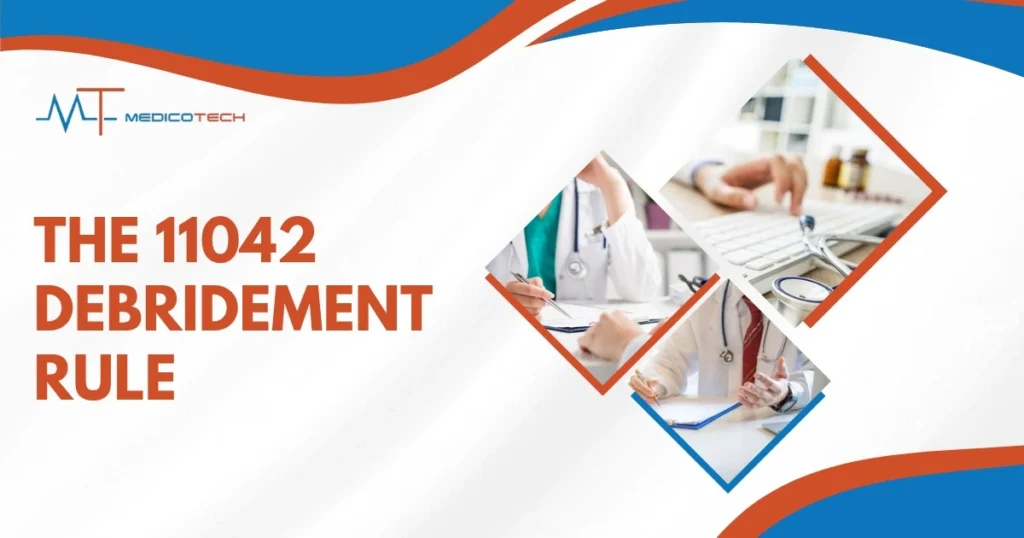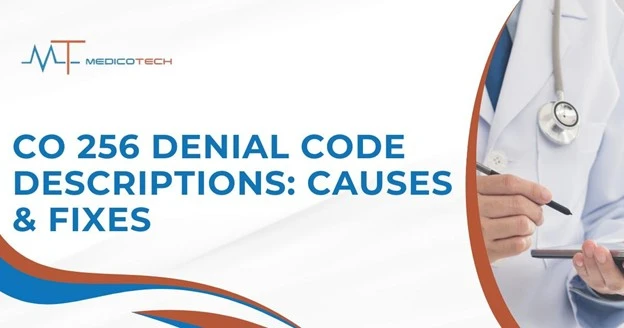CPT Code 11042 is essential in the wound care particularly in the wound care involving non-traumatic wounds that need to undergo a surgical intervention that involves removing necrotic or infected materials. Knowing how to effectively apply this code would guarantee the proper billing, effective reimbursement, and patient care. As a healthcare provider or a medical billing professional, being aware of the particularities of this code can help develop your working process and prevent making mistakes with coding.
What is CPT Code 11042?
CPT Code 11042 is applied when the surgical debridement of subcutaneous tissue (fat and connective tissue) is done to the wounds that exceed 20 square cm in their size. This is an operation code and is required in case of dead or infected tissue of the subcutaneous layer that requires removal in order to enhance healing and to avoid complications. The point is, it is important to know that this code is only used in the removal of necrotic tissue of the subcutaneous layer and not the deeper tissues, such as muscle or bone.
Significance of CPT 11042 to Billing of Wounds
The CPT Code 11042 plays a crucial role in the correct billing in the wound care management. This code enables health professionals to receive compensation of their services whenever they undertake the process of debridement on non-traumatic wounds such as ulcers, gangrene, and chronic infections. This can be done properly to allow healthcare facilities to be recompensed on the time and resources spent in healing such wounds. Furthermore, a proper CPT code will be able to make the system compliant with insurance laws, and reducing billing errors or refusals.
Understanding Wound Debridement
What is Wound Debridement?
Debridement is a procedure in medicine where dead, damaged or infected tissue is removed in a wound. Debridement removes necrotic tissue and thus decreases the chance of wound infection and debridement prepares the wound to grow new, healthy tissue. The nature of debridement being done is based on the size, location, and severity of the wounds.
Types of Debridement Procedures
Debridement procedures are of several different types:
Surgical Debridement
The most invasive technique whereby the necrotic tissue is removed using scalpels or scissors. This technique is normally applied on large, deep wounds or on ones, which have failed with the other procedures.
Autolytic Debridement
A more conservative approach which entails using natural enzymes and moisture of the body to break the dead tissue. This is a slower type that is most appropriate in small less infected wounds.
Mechanical Debridement
It includes the literal excision of necrotic-based tissue which may be facilitated by gauze, irrigation, or hydrotherapy. It is normally applied in wounds that are moderately infected.
Enzymatic Debridement
Implicates the use of enzymes on the wound to decompose the dead tissue. It is simple in case of less serious, though smaller wounds.
Biological Debridement
Eats maggots to feed on dead body. This technique is mostly applied to non-healing wounds that are chronic.
Key Details of CPT Code 11042
Procedure Covered by CPT Code 11042
CPT Code 11042 assists the removal of dead tissue of the fat and connective tissue layer just under the skin, which is included in the debridement of subcutaneous tissue. This is not applicable to deeper tissues such as muscles or bones, although they might be involved in the wound. This code is essential in the process of healing wounds such as chronic ulcers, gangrene, and other non-traumatic wounds where necrotic tissue needs to be removed for improved healing. The procedure can be crucial in general surgery when dealing with large, infected, or necrotic wounds that require surgical intervention for proper wound care.
Applicable Wounds for CPT Code 11042
CPT Code 11042 is applicable mostly on non-traumatic wounds that involve cuts on the subcutaneous layer of skin. Common examples include:
Chronic ulcers
They may arise as a result of such conditions as diabetes or venous insufficiency.
Gangrene
Dead tissue which could be due to infection or poor circulation.
Infected wounds
Infection of the wounds and dead tissue that should be removed.
It is necessary to mention that a CPT code should be chosen to cover other procedures (e.g., CPT 11043 or 11044) in case of deeper involvement of the tissue (muscle or bone).
Size and Depth Considerations
CPT 11042 applies to the wounds, which have a debridging area of 20 square cm or less in subcutaneous tissue. In case of wounds bigger than this, an add-on code +11045 takes care of every additional 20 square cm of tissue excised. The dimensions of the wound and the depth of the tissue being debrided are the determinants to apply the correct CPT code and hence knowledge of these aspects would guarantee proper billing and reimbursement.
Application of CPT Code 11042 in Medical Billing
How to Report CPT Code 11042 Step by Step
Identify the wound
Establish that the wound needs to be debridged at least of the subcutaneous layer. In case of muscle or bone deep tissues and debridement is necessary, another CPT code is to be applied.
Measure the wound
Make sure that it is not more than 20 cm 2. When the wound is larger, add-on code is to be applied in (i) plus 11045 each 20 square cm.
Document the procedure
Properly record the procedure that did take place and what part of the tissue was taken off and any complications or extra services involved.
Use the correct modifiers
In case debridement procedure is different to other services offered on the same day, modifier -59 is used to specify different procedure.
When to Use CPT 11042
CPT 11 042, when it is necessary to debridement the subcutaneous tissue of the non-traumatic wound and it is 20 or less square cm, should be utilized. In case of additional removal of tissue (e.g. muscle or bone), the suitable CPT code of these tissues (e.g., CPT 11043 of muscle) must be used. This code is also applied in cases where a certain debridement procedure is undertaken as a stand-alone procedure as opposed to performing other procedures that share a day.
Bundling with Other CPT Codes
In this situation involving wound care, proper reimbursement requires proper coding. CPT code 11042 has a key role to play in reporting the debridement services especially on the wound that includes both the skin and the subcutaneous tissue. But to have proper billing procedure and to maximize on reimbursement, it is important that CPT 11042 is used in conjunction with other codes of debridement and modifiers. This and the following information will explore the complexities of CPT 11042, such as the bundling and modifiers, other codes, reimbursement rules, and payment optimization tips.
Bundling of CPT 11042 and Deeper Tissue Debridement Codes
Bundling is the process that includes combining similar medical procedures in a single complex billing code. CPT 11042, which code includes debridement of skin and subcutaneous tissue, may be combined with more comprehensive codes of tissue debridement when a larger operation is done.
Example:
- CPT 11043 Used for muscle debridement.
- CPT 11044 Used for bone debridement.
It is standard to bundle CPT 11042 with CPT 11043 when debridement is done on the skin and muscle, including a deep tissue. The selection of the procedure code is based on the depth of the tissues that are under treatment and the kind of services being offered.
Bundling (e.g. CPT 11043 – Muscle Debridement)
We will take the example of a scenario in which the upper tissue and deep tissue should be debrided:
Example
A patient is brought with a deep wound which includes the skin layer and the under skin of the muscle. The procedure may involve:
- CPT 11042 of skin and subcutaneous tissue debridement.
- CPT 11043 for muscle debridement.
It is possible to bundle these two codes together in this situation since they are treating the distinct levels of tissue in the wound. These codes should be bundled in accordance with the billing code to avoid billing denials.
More Contrasts of CPT Code 11042
CPT 11042 should be used before taking into account the following:
Wound Depth
CPT 11042 should be used in the debridement of skin and subcutaneous tissue. In case other deeper tissues are involved like in case of muscle or bone, then other codes such as CPT 11043 (muscle) or CPT 11044 (bone) must be used instead.
Wound Size
The coding is also determined by the size of the wound. In case of larger wounds, you might require using some additional codes such as +11045 (wounds larger than 20 square cm).
Complexity
When having more complex cases, i.e. in cases when it comes to several layers of tissue, the coding guidelines should be considered in detail with the purpose of registering the maximum amount of fees.
Modifiers for CPT 11042 (e.g., Modifier -59)
CPT coding has the use of modifiers to give more information on the services done. When the CPT 11042 is combined with other codes (e.g., CPT 11043: the muscle debridement), some requirements may be necessary to avoid the codes as bundled services.
Modifier -59
The most widespread modifier in this case is Modifier -59, that states that a procedure is different or independent of another procedure done on the same day.
Example
And in case you debride both skin and muscle tissue in different parts of the body, use Modifier -59 to indicate that they are two different procedures; not a bundle of one.
Further Codes to Larger Wounds ( +11045)
Codes should have more information to capture the increased complexity of the procedure in larger wounds, which exceed 20 square centimeters in size.
CPT +11045
This add-on code is implemented when debriding a wound in an area over 20 cm 2. Use this code should be CPT 11042 when it comes to doing a debridement on a big wound. The complexity and effort added to the big wound should be represented via this code.
Example
Superficial debridement needs a CPT 11042 and +11045 needs to be applied to cover the greater surface area.
Common Mistakes in CPT 11042 Reporting
To reimburse properly there should be accurate reporting. The errors that can be made with CPT 11042 are:
Unbundling
No efforts to further thole tissue codes like CPT 11043 or CPT 11044 as required. The consequence of this may be lost reimbursement or claims rejections.
Using Incorrect Codes
CPT 11042, which is used to treat wounds with underlying structures, like musculature or bone, may result in underreporting. It should be applied in the codes such as CPT 11043 or CPT 11044 in such instances.
Overlooking Wound Size
This may result in under-reimbursement due to failure to report the right wound size. Make sure that big wounds should be noted using +11045.
Errors to Avoid When Using CPT Code 11042
Some of the main things to look out to in order to prevent the mistakes during billing are:
Mistaken Usage of the modifiers
The use of modifier -59 is correct in order to distinguish different procedures on the same day. It must also not be used without necessity and this can send signals to the insurers.
Providing the Wrong Combinations of Codes
CT 11042 should not be used with other codes that do not relate to the wound care session at which the procedure was also provided.
Complexity of the Wound Underestimated
Make sure the depth and the size of the wound are properly recorded. Big or complex wounds should have more codes and additional modifiers so that they could be reimbursed appropriately.
Reimbursement and CPT Code 11042
This is an important step to understanding how CPT 11042 is reimbursed to make sure that health givers are paid well. Reimbursement on this procedure is determined by a number of factors:
Insurer Policies
Every insurance company can have particular regulations concerning reimbursement of wound care. Make sure that you are up-to-date with the policies of the payer so as to prevent delays and denials.
Wound Size and Complexity
The more complex or bigger wounds which may involve further services such as +11045 have a higher rate reimbursement.
Modifier Use
Correct use of modifiers will make the payer know the conditions in which each service was offered, thus possibly preventing the denial or lower payments.
Learning Payment and Reimbursement CPT 11042
CPT 11042 reimbursement will be based on a number of issues:
Payer Specific Policies
Various payers might provide a different reimbursement rate and directions of wound care. Inquire regularly with the payer on the current practice in billing.
Wound Type
Complex or large wounds (e.g., more than 20 cm 2 ) could be associated with increased reimbursement rates.
Modifier Application
The correct use of modifiers, such as Modifier -59 can be one of the factors that guarantee the fact that individual services are reimbursement-appropriate.
Reimbursement Maximization tips
In order to maximize the reimbursement of CPT 11042, the following tips should be taken into account:
Accurate Documentation
It is then clear to document the size, depth and complexity of the wound to warrant the codes applied.
Understand Payer Policies
Get yourself acquainted with the rules and regulations of the insurers on wound care services to evade the denials and delays.
Use Modifiers Correctly
Modify them use separate techniques such as modifier-59 where needed to reduce bundling errors.
Key Takeaways for Wound Care Providers
- Board the CPT 11042 properly along with high level tissue debridement codes such as CPT 11043.
- Use Modifier -59 to differentiate distinct procedures and prevent problems of claims.
- Enter +11045 in case of large wounds and report them accurately to be reimbursed.
- Prevent typical errors of coding such as unbundling or miscoding wound depth.
- Stay informed on payer-related reimbursement policies in order to maximize payment on wound care processes.
Conclusion
CPT code 11042 is important in wound care since a proper reimbursement and billing on it necessitates that the code interacts with other debridement codes and modifiers. Through adequate bundling of CPT 11042 with such other codes as CPT 11043 of deeper tissue debridement, modifying them where required and recording wound complexity, healthcare providers are most likely to receive reasonable reimbursement of their services.
CPT 11042 is applied in debriding superficial skin and subcutaneous tissue. With further codes such as CPT 11043 (muscle) and CPT 11045 (when dealing with large wounds), this would be properly bundled and billed. The correct use of such modifiers as Modifier -59 will contribute to eliminate the problem of bundling and make sure that different procedures are paid separately.
FAQs
What is CPT Code 11042 used for?
Ans. CPT coding of debridement on both the skin and subcutaneous tissue is coded as 11042. The code is usually adopted in cases where the wound touches the tissue and superficial parts of the skin.
Can CPT 11042 be bundled with other codes?
Ans. Yes, CPT 11042 can be combined with other debridement codes, which is CPT 11043, the debridement of muscle, or CPT 11044, the debridement of bone when they are both done during a single visit.
Where applicable in conjunction with CPT 11042 – Modifier -59?
Ans. Modifier -59 is applied to show that the procedures are different and independent of one another which usually may be applied to a different part of the anatomy. This adjective is used to make sure that grouping of procedures which are wrongly combined is not done.




